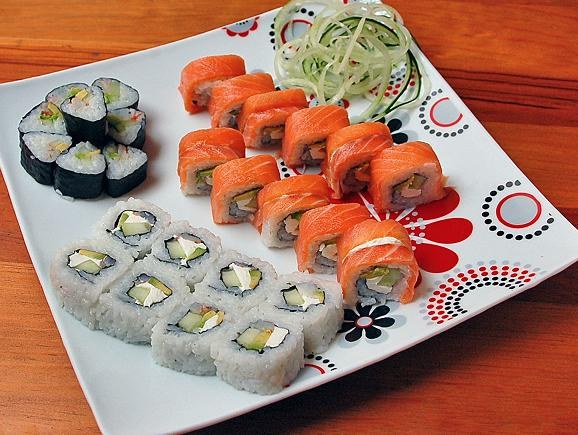You will need
- fish (salmon
- acne
- tuna
- perch);
- a sharp knife or a special Japanese knife DeBa, Buco.
Instruction
1
Hosomaki (thin rolls with one or two ingredients) In the form of rolls filling wrapped in a coat of rice, raspredelennoi on a sheet of nori (Japanese seaweed). Despite the seeming simplicity of cooking these rolls is difficult, because the roll should be tight and uniform. So cut the fish fillets (salmon, tuna, eel) long narrow strips of 1 cm width. If the additional ingredient is used vegetable (for example, the classic combination of salmon, avocado or eel-cucumber), it is cut the same strips. Shrimp for the stuffing not cut, they simply laid in a straight line, as a rule, two shrimp for one loaf.
2
Futomaki (thick rolls with multiple ingredients to five or six) Fish cut like hosomaki. The difference between these types of rolls is in the number of ingredients. In one roll can be three kinds of fish and several kinds of vegetables.
3
Sakaki (inside out rolls)these rolls the sheet of nori is laid on a pillow of rice and fish is used either as toppings ("CA"), or to wrap ("Philadelphia"), you Can add up to three additional ingredients, including sauces (e.g., Japanese mayonnaise). Cooking them seems daunting, but it is only at first glance. Fish for stuffing, cut also like hosomaki, and to wrap the required thin wide strips. This fish fillet is cut obliquely, as a rule, the slices turn out rectangular. Do not rush to strip is not torn, don't make them too thin, they should be slightly translucent, about 2 mm thick. Prepared roll gently lay wide strips of fish, wrap tightly and then cut into pieces.
4
Temaki (literal translation from Japanese "rolls formed in his hands") the Fish cut into thick (1 cm) rectangular strips diagonally and then cut each slice diagonally to make two triangles. This type of slicing is convenient when twisting because it follows the shape of the temaki.
Note
For cutting fish Japanese cuisine uses a very sharp knife, be careful when cutting diagonally.
Useful advice
For futomaki use the whole nori sheet (about 20 cm), hosomaki - half.
